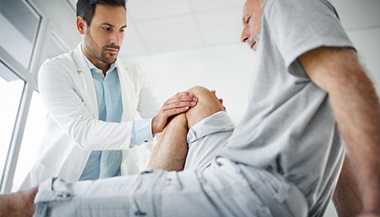Knee Injections for Pain Relief
Knee pain can take a toll by interfering with work, leisure and daily activities. Knee injections can help manage the pain and other symptoms such as stiffness and limited movement.
What You Need to Know
- Knee injections can treat pain and stiffness associated with arthritis as well as help people recover from injuries.
- A variety of injections are used to treat knee pain, and researchers are studying new types of injections.
- Most knee injections provide temporary relief from pain. Symptom relief may last several months or sometimes longer.
What are knee injections?
Knee injections contain drugs or other substances that are delivered directly into the knee by needle. These treatments are relatively simple, nonsurgical procedures that can bring knee pain relief for a variety of problems.
Who can benefit from knee pain injections?
Knee injections can be used to treat people with a variety of knee problems, such as the following:
- Knee Arthritis: Arthritis causes pain, stiffness and limited movement. It can be caused by age-related wear and tear (osteoarthritis), overuse or injuries, or an autoimmune condition such as rheumatoid arthritis. Knee injections have been most widely studied in people with osteoarthritis, but some are also available for people with inflammatory arthritis.
- Injuries: The knee is vulnerable to injuries, including damage to ligaments, tendons and the meniscus (cartilage that cushions the joint).
Types of Knee Injections
Several medications and therapies can be injected into the knee. Before recommending an injection, your doctor will examine the knee and may order imaging tests to determine the cause of pain. Together, you will discuss the findings and determine whether to move forward with an injection and what type is best for you.
Cortisone Shots in the Knee
Corticosteroids (cortisone) injections are often used to treat arthritis-related knee pain. Corticosteroids are powerful medications that reduce inflammation.
When injected into the knee joint, cortisone can control inflammation and pain for several weeks or months. These treatments work better for some patients than others. A person who does not experience pain relief after one or two injections has a low chance of improving with additional cortisone injections.
It can take up to a week after the cortisone shot for symptoms to improve. While effective, cortisone shots should not be given more than three or four times per year. Receiving the shots too often can lead to damage of the knee joint.
Platelet-Rich Plasma Knee Injections
Platelet-rich plasma (PRP) injections are treatments made from a patient’s own blood. The blood sample is processed to create a high concentration of blood cells called platelets, which have growth factors that stimulate healing and tissue regeneration.
Scientists are studying how to make the most effective platelet mixtures. Research shows that PRP can relieve symptoms of mild to moderate osteoarthritis of the knee. It is also used to treat injuries to soft tissues such as tendons and ligaments.
One PRP injection may be enough to provide long-lasting or, in many cases, permanent pain relief. Some people benefit from a series of injections.
It is important to note that the effects of PRP are not immediate and may take several weeks to become noticeable as the body undergoes the healing process. While research is ongoing, PRP offers a minimally invasive treatment option that may promote faster recovery and reduce the need for more aggressive interventions.
Gel Shots for Knees (Viscosupplementation/Rooster Comb Injections)
Gel shots are treatments that contain hyaluronic acid — a substance normally found in the knee that acts like a shock absorber and lubricates the joint. People with osteoarthritis have less of this natural gel than they should.
Gel shots are used to supplement low hyaluronic acid to decrease pain and improve function. That’s why this procedure is also called viscosupplementation. These treatments are also known as rooster comb injections because the hyaluronic acid formerly came from processed chicken combs (the red growths on top of chicken’s heads). Manufacturers have shifted away from using animal by-products and toward sourcing hyaluronic acid from bacterial cultures and other synthetic, botanical and fermented methods.
After the gel shots, some people experience pain relief for several months. Doctors typically inject hyaluronic acid into the knee with one to five shots, each given about a week apart. The injections can be repeated every six months or so. Not all people experience pain relief.
Prolotherapy for the Knee
Prolotherapy is an injection of a sugar water solution into knee joints damaged by osteoarthritis. The solution is thought to act as an irritant, stimulating the body’s natural healing process to repair the damaged joint. The treatment may promote cartilage growth over time, but it is not entirely clear how this process works.
Prolotherapy is considered an alternative treatment. It is not regulated by the U.S. Food and Drug Administration (FDA).
Prolotherapy is typically given once per month for three to four months.
Some studies show that prolotherapy reduces pain and improves function for people with osteoarthritis, but other research suggests it may be less effective than other treatments. Studies have not followed people in the long term, so it is unclear how long the effects might last.
Experimental Shots for Knee Pain
Researchers are also exploring other injections for knee pain. (These treatments show promise but have not been approved by the FDA for treatment of knee pain.)
Autologous Conditioned Serum
Like PRP, this treatment is made from a person’s own blood. The blood sample is altered so it contains a high concentration of immune cells and growth factors that encourage tissue regeneration. It is injected into the knee in a series of four to six shots given over several weeks.
The treatment may reduce inflammation and boost the body’s ability to repair damaged cartilage. Some studies suggest that autologous conditioned serum can lessen osteoarthritis pain and may help heal injuries such as tendon or meniscus injury.
Stem Cell Knee Injections
Stem cells are naturally found in the human body. These cells have the power to develop into many types of cells, and they play an important role in repairing tissue throughout the body. Some studies indicate that stem cell injections may reduce inflammation and support cartilage-producing cells in the knee.
The number of injections a person needs depends on the problem being treated. Findings so far suggest that stem cell injections may relieve pain for up to 12 months or longer, in people with osteoarthritis. Some evidence suggests that stem cells could slow progression of knee osteoarthritis if started during the early stage of the disease. Researchers are also studying the effects of stem cell treatments for people with soft-tissue knee injuries.
Botulinum Toxin for Knee Pain
Injections of botulinum toxin are used to treat wide-ranging conditions including migraines and muscle spasms. Some research suggests botulinum toxin injections can also help with arthritis.
Botulinum toxin is used to treat both osteoarthritis and autoimmune arthritis (such as rheumatoid arthritis) of the knee. The medication is injected into the knee joint. After a single treatment, patients may experience less pain and greater range of motion for three to 12 months. The treatment can be repeated.
What happens during knee injections?
Knee injections are common procedures. They are performed in a doctor’s office while you are awake. Here’s what to expect.
- The injection is prepared. Usually, it contains a numbing agent in addition to the treatment.
- The doctor cleans the skin and typically applies a spray to numb the area.
- The doctor inserts the needle into the knee joint, often while using ultrasound or X-rays to guide the needle to the right location.
- Sometimes, the doctor will perform a procedure called knee-joint aspiration before the injection. Aspiration removes excess joint fluid from the knee, which can help relieve pressure. The fluid can be tested to help determine the cause of pain.
- Once the needle is positioned in the right spot, the doctor injects the medication. Usually, the treatment is injected into the joint capsule, which is the space between the bones inside the knee. Some treatments are injected into the tissues surrounding the knee.
- The needle is removed, the injection point is bandaged, and you can return to the activities of your day.
Pain may decrease immediately after the shot because of the numbing medication used during the procedure. Pain might return within a few hours, after the numbing medication wears off. It can take a week or more before you start to notice pain relief from the injection.
Immediately after a knee injection, you might have swelling or irritation around the injection site. You can ice the knee and take over-the-counter pain relievers as needed. Avoid doing too much physical activity for the first 48 hours after treatment.
Knee Injection Risks
Knee injections are relatively simple procedures. Like any medical procedure, joint injections have some risks. These include:
- Pain, swelling or bruising at the injection site
- Allergic reaction
- Infection
- Damage to the joint or nerves
People with diabetes may have a temporary increase in blood sugar for a few days after receiving a corticosteroid injection. If you have diabetes, talk to your doctor about your blood sugar and the possible risks before having a cortisone shot.
When Joint Injections Stop Being Enough
Joint injections can make a big difference in knee pain. But regarding knee arthritis, their effects may become less powerful over time as arthritis becomes worse. Also, the number of injections a person should get in a year is limited. This number varies depending on the type of injection. If knee pain begins to interfere with your quality of life, it might be time to consider other options.
If you and your doctor have already tried all nonsurgical treatments, including physical therapy, surgery may be needed to address the root cause of knee pain. People with painful knee osteoarthritis could benefit from knee replacement surgery. If knee pain and stiffness are preventing you from doing things you want to do, talk to your doctor about your options.






